I regarded its appearance as an opportunity to observe the sapsucker's plumage transition into that of a full adult. This happened over the next 10 weeks, but we also gained insights about its habits and its fighting nature when it came to squabbles over rights to its favorite tree. We did not expect to become directly involved in a confrontation with this little creature, but eventually love turned to hate and a life was at stake.
These photos taken December 24, 2013, which showed a hint of red on the bird's forehead and a lack of any red feathers on its throat, suggested that it was a female.
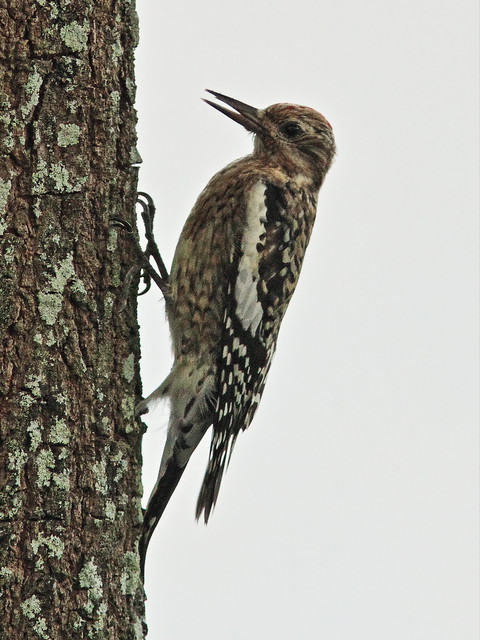
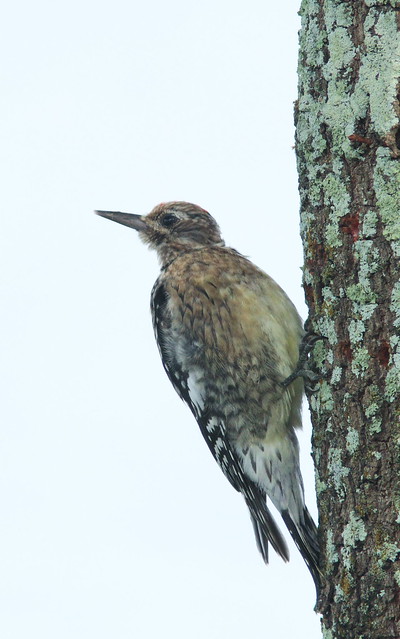
The next day (December 25) I was able to better document the red area on its crown. The large number of sap wells on the tree suggested that it had gone unnoticed for several days.
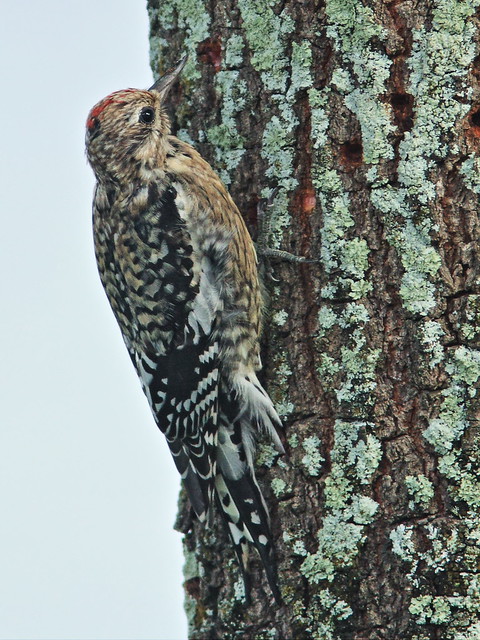
The sapsucker stayed with us for an extended period. It visited daily, sometimes appearing before sunrise and tarrying until after sunset. It often was present for several hours each day, busily drilling holes, drinking the sap and eating the insects it attracted. We watched as its plumage gradually matured.
On January 13, 2014 the red area was a bit more noticeable.
According to experts, the plumage change in this species is very gradual and often not complete before it migrates back to breeding grounds to the north. Yet, only five days later, on January 18, I thought it had undergone a rapid and dramatic transformation.
However, I was wrong, for a moment later I noticed that there were TWO sapsuckers on the tree, the adult female pictured above as well as to the right in the photo below, and our familiar juvenile bird.

The adult sidled up beside the youngster, which I took as a friendly gesture, but before I could raise my camera they locked in a ferocious battle. Both fell to the ground, out of sight behind a hedge. Moments later, the adult bird flew away, apparently defeated by the juvenile.
The adult bird showed up again on February 2, appearing very alert and anxious that the rightful owner of the sap tree might show up. Although the second bird did return briefly a couple of times, we never saw both together after that.
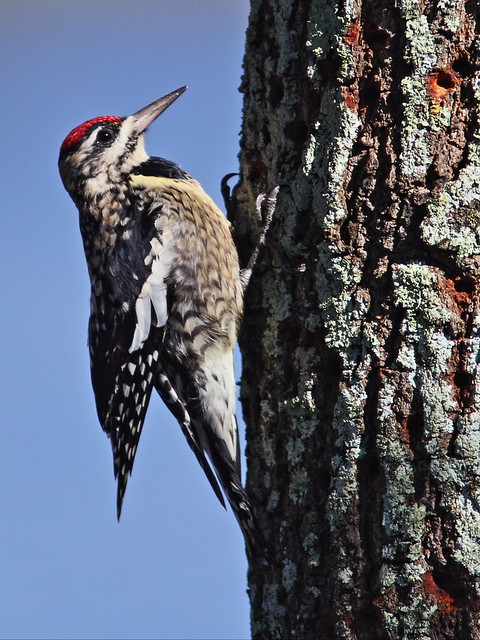
The young bird resumed its peaceful routine, tapping holes and feeding on our tree. On February 9, 2014 she had developed a black "bib." and her facial markings were more distinct. The red area had enlarged, covering the entire top of her head.
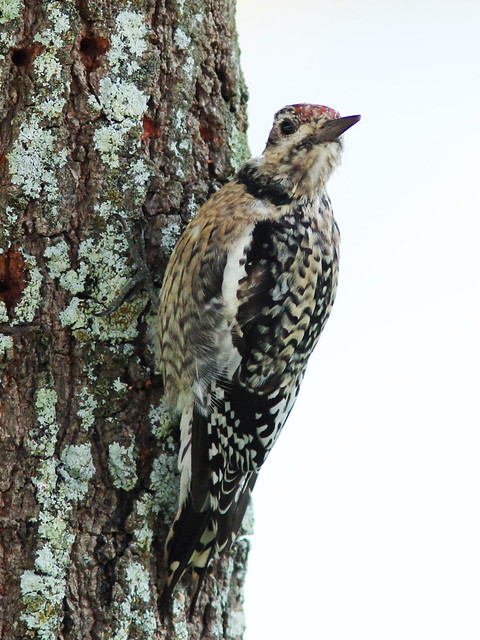
The bird was almost invisible when foraging with her back to us. No wonder we had not noticed her earlier. Here she is on February 16, 2014.
On the morning of February 23 the adult reappeared briefly, again looking around all the time as if in fear of being discovered. This time I had my best photo opportunity. Because I did not want to scare the birds, most of my previous shots were taken through the back window of our home. For this one, I sneaked out the front door and stole around the side of the house with the sun at my back.
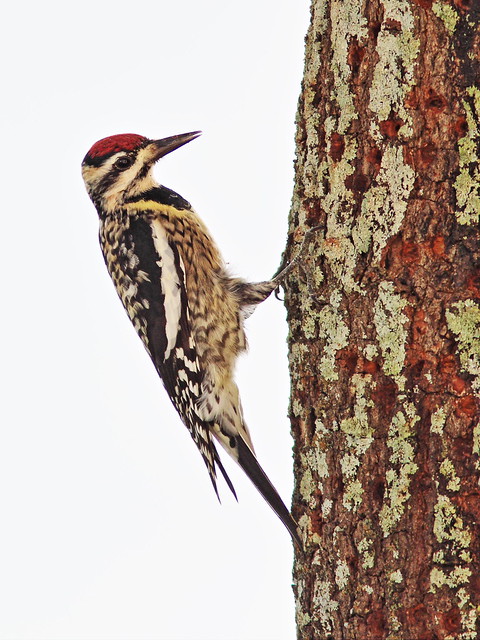
Later that day, the immature sapsucker resumed an interesting series of encounters with a Yellow-rumped Warbler that was intent on stealing from its larder. The warbler often perched on a plant hanger pole, waiting for the sapsucker to disappear on the other side of the trunk.
As quickly as the warbler landed, the woodpecker chased it away. It rarely had time to explore one of the sap holes.
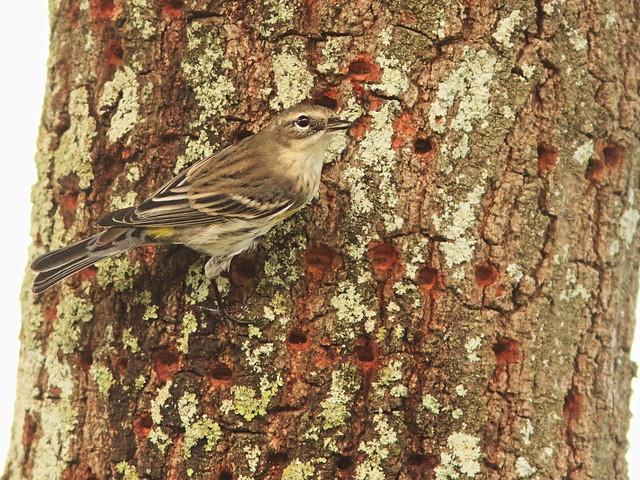
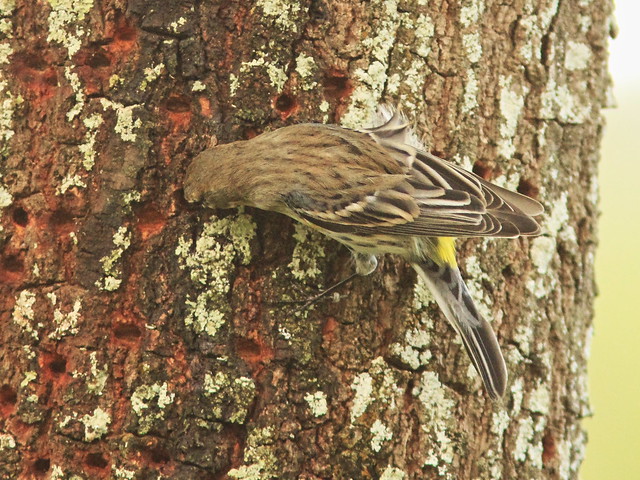
The chase went on for hours. The sapsucker might fly away but return in a flash as soon as the warbler perched on the coveted tree. They never came to blows; the warbler was much too quick.
By February 28 her crown was almost as extensive as that of the adult, and facial markings were more distinct.
Mary Lou expressed concern about the damage that the sapsucker was inflicting. Based upon my cursory research, I reassured her that we would be dead and gone before the bird could do serious harm. We continued to enjoy its presence.
Under local laws, each new home must have at least one native tree. Our mahogany qualified as such, and we were very fond of its symmetrical spread. Our deck faces east, and the tree casts welcome morning shade.
Sapsuckers do not "suck" sap , but their brushy tongues are specialized to lap it up. They also eat insects attracted to the sap, and I was surprised to learn that about a quarter of their stomach contents consist of tree tissues extracted from under the bark.
They drill holes through the bark into the vascular layers that transport water and nutrients. Xylem, just under the bark, circulates water up from the roots. Phloem lies next to the wood and carries nutrients manufactured by the leaves to those parts of the tree that are actively growing. It mostly flows down to the roots, but also redirects nutrients to any part of the tree that requires energy, such as new buds, flowers and fruit. Between the xylem and phloem is a multipotential layer of cambium, a permeable membrane which produces the cells that make up the two vascular layers and regulates movement of water between them.
Most of the literature about sapaucker tree preferences focuses upon the northern areas where the birds breed. They are known to attack over 1,000 tree species, but were said to favor birch, maple and fruit trees. An Internet search revealed that a western species (the Red-breasted Sapsucker) caused extensive damage to Curlleaf Mountain-Mahogany. In the Florida Everglades, the West Indies Mahogany is a frequent host. We noticed that the northern side of our tree was turning yellow and the leaves were falling off. The main branch that supports this area was most densly riddles with sap wells.
Thus began our war against the sapsucker. We started with water pistols and escalated to streaming a jet from our garden hose, but the sapsucker either just moved higher up the tree or flew to an adjacent mango tree and returned to the mahogany as soon as we moved away. We draped the trunk with canvas, but the bird just moved its activities to areas above and below the fabric.
Although the bird should be returning north within a few weeks, we did not want any further damage, so we resorted to using a sticky substance which deters birds from roosting. So far it has worked. The sapsucker should be returning north very soon.
oh, sorry it was causing enough stress to the tree to warrant protective measures! hope the tree recovers well. this was a lovely series of shots, though.
ReplyDeleteExcellent documentation of these gorgeous birds Ken! Terrific detail in your photos.
ReplyDeleteWell it was (is) a beautiful bird and I was going to say I'd have been happy to have one show up in my yard as a Christmas present. But perhaps not. Interesting about the 'local tree' ordinance.
ReplyDeleteIt's great to be able to watch amazing birds like these from your own home. I really like the rule that you have to plant a native tree, and I am sorry that yours has been damaged, but I still really like those woodpeckers. From Findlay.
ReplyDeleteTruly amazing photos and commentary. Who would have thought a single bird could cause that much stress on your beautiful tree.
ReplyDeleteVery interesting post! Fascinating to see the plumage changes in the bird. So much damage to the tree caused by one bird - wow! I hope the tree has a chance to rejuvenate once the bird moves north.
ReplyDeleteHow wonderful to get to watch them so closely. I'm sorry about your tree though, I hope it recovers.
ReplyDeleteWhat a great place, and so much to see!
ReplyDeleteNice serie!
Outstanding Ken!!!! Each picture and your commentary!!!
ReplyDelete...too bad about the damage on your tree tho.
Cool series on the Sapsucker. I like the twofer shot.. Great post..
ReplyDeleteMy goodness Ken, I'm exhausted, what a read, like the saying goes, you learn somthing every day, thanks.
ReplyDeleteAnd all the best Gordon.
It has been a long time since I've seen a sapsucker. It looks like you got to spend quite a bit of time with them.
ReplyDeleteThis reminds me of our ceaseless conflict with the possums - a tree dwelling marsupial that comes down to eat our vegetables!
ReplyDeleteGreat set of pictures.
Commenting is just part of the world of blogging - but sometimes you can and other times you can't - its staying "in touch" that's important. I think the person who sent me the email was having a bad day!!
Cheers - Stewart M - Melbourne
Oh My Goodness, we have these beauties and while they peck holes to drink of the sap from many of our 2 acres of trees, I have never witnessed anything like this. I sure hope you can save your tree, bummers. They are one of my top 10 favorite birds, and you got beautiful images~
ReplyDeleteA fascinating post with great photos. I never would have thought that a single bird could do so much damage to a tree.
ReplyDeleteKen, just stopping back to say thank you for linking up to my critter party. Have a happy Sunday and week ahead!
ReplyDeleteGreat photos! The tree had so many peck holes amazing. :) thanks for sharing
ReplyDelete